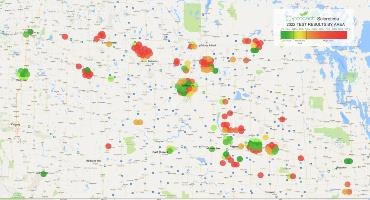Quantum Genetix releases its 2023 Sclerotinia map for the Canadian Prairies.
By Andrew Joseph, Farms.com; Images courtesy of Quantum Genetix
Although no Canadian farmer is happy to have their crops afflicted by drought, the drier soil conditions and hot temperatures are at least partially responsible for a reduction of Sclerotinia—Sclerotinia Stem Rot—rearing its ugly head so far in 2023.
Thanks to its customers sending in canola petal samples for Sclerotinia testing in mid-June through mid-July, Quantum Genetix has updated its Sclerotinia map for the 2023 Prairies. The company has provided a Sclerotinia map annually since 2016.
Steven James, the Director of Research & Development at Quantum, spoke to Farms.com about the new data.
"It’s important to note that this map is not a predictor," he said. "It’s a summary of sclerotinia spore presence in our customers’ fields over that mid-summer period."
This white mold stem rot—aka Sclerotinia sclerotiorum—is influenced by environmental conditions leading up to and during the flowering period of canola and other crops.
Although Sclerotinia slows its appearance during hot, dry weather, such as what has affected much of the Prairies, James noted that weather conditions vary widely over areas—including a large farm.
"It’s a difficult disease to predict," noted James. "Just because it showed up last year doesn’t mean it’s showing up this year or next. However, that doesn’t mean that it won’t.
"The best thing any farmer can do is test their crop."
If the report provided by Quantum Genetix indicates that Sclerotinia may be present in the crop, it gives the farmer the opportunity to spray a fungicide—hopefully in time—to stem its spread.
James said that Sclerotinia easily survives the harsh prairie winters and can even remain dormant in the soil for five years or more. And just because it was sprayed for in the previous season does not mean it won’t show up this year.
View the 2023 Sclerotinia map at the top of this article. Although many of the crop petal samples provided around North Battleford, Saskatchewan, show a low risk of the disease, there are other areas within its sphere where there is a high risk.
When compared to the 2022 map immediately below, the majority of the customers in the North Battleford area appear to have been hit with a high risk of Sclerotinia becoming an issue.

When compared against the 2023 map, it is proof that annual crop testing is still the best preventative solution against Sclerotinia.
This crop disease requires a high degree of farmer vigilance to have the best odds of containing it and saving a crop.
Headquartered in Saskatoon, Saskatchewan, Quantum Genetix offers a 24-hour turnaround after receiving a sample.
For more information on Quantum Genetix, visit https://quantumgenetix.com/.